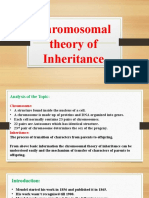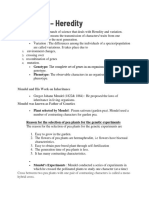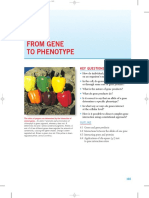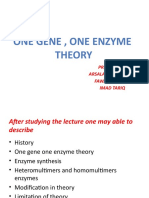0 ratings0% found this document useful (0 votes)
27 viewsBoveri and Sutton - Beadle and Tatum
Uploaded by
MphoCopyright
© © All Rights Reserved
We take content rights seriously. If you suspect this is your content, claim it here.
Available Formats
Download as PPTX, PDF, TXT or read online on Scribd
0 ratings0% found this document useful (0 votes)
27 viewsBoveri and Sutton - Beadle and Tatum
Uploaded by
MphoCopyright
© © All Rights Reserved
We take content rights seriously. If you suspect this is your content, claim it here.
Available Formats
Download as PPTX, PDF, TXT or read online on Scribd
You are on page 1/ 7
The Chromosomal Theory of inheritance,
Genetics of sex proposed by Sutton and Boveri
Theodor Boveri (1862-1915) and Walter Sutton (1877-1916) propose that chromosomes
bear hereditary factors in accordance with Mendelian laws
• Mendel had worked with traits of whole organisms.
• He did not investigate how characteristics are sorted and combined
on a cellular level, where reproduction takes place.
• During Mendel’s experimentation, the society was not acceptable
to drastic changes in their scientific ideas.
• They could not believe the existence of such discrete factors such
as genes which would segregate without mixing as this did not
support their idea of the constant changes leading to evolution.
• Moreover, the means of communication was poor at that time as a
result of which, the information could not be conveyed to the
masses.
• Also, Mendel’s mathematical approach to prove biological laws was
unacceptable. ??
The Chromosomal Theory of inheritance,
• As time passed, scientists Vries, Correns and Tschermak
discovered chromosomes which existed inside the nucleus.
• The American Walter Sutton and the German scientist Theodor
Boveri (1902) observed the behaviour of the chromosomes when
the cells were divided.
• With the advancements in the microscope, this task became
easier. Hence, they proved Mendel’s laws with the help of
chromosomal movement.
• Boveri and Sutton (1902), working independently, suggested that
chromosomes could be shown to bear the material of
heredity. !!!
• Mendelian concepts, as it turned out, had an excellent fit with
facts about chromosomes.
The Chromosomal Theory of inheritance ; came into existence
long after Mendelian genetics
The Chromosomal Theory of inheritance,
• Boveri had previously shown that chromosomes remain organized
units through the process of cell division, demonstrated that
sperm and egg cells each contribute the same number of
chromosomes and that proper embryonic development of sea
urchins does not occur unless chromosomes are present?.
• That same year, Sutton observed the separation of chromosomes
into daughter cells during meiosis.
• Together, these observations led to the development of the
Chromosomal Theory of Inheritance, which identified
chromosomes as the genetic material responsible for Mendelian
inheritance.
• The idea of chromosomal segregation combined with the
Mendelian principles gave rise to the chromosomal theory of
Inheritance.
The Chromosomal Theory of inheritance
It is the fundamental theory of genetics.
• According to this theory, GENES are the units of heredity and are
found in the chromosomes
But does each chromosome have specific properties?
Is a full complement of chromosomes necessary for reproduction and
development?
An electron micrograph of a human chromosome XII
The Chromosomal Theory of inheritance
The Chromosomal Theory of Inheritance was consistent with
Mendel’s laws and was supported by the following observations:
• During meiosis, homologous chromosome pairs migrate as
discrete structures that are independent of other chromosome
pairs.
• The sorting of chromosomes from each homologous pair into
pre-gametes appears to be random.
• Each parent synthesizes gametes that contain only half of their
chromosomal complement.
• Even though male and female gametes (sperm and egg) differ in
size and morphology, they have the same number of
chromosomes, suggesting equal genetic contributions from each
parent.
• The gametic chromosomes combine during fertilization to
produce offspring with the same chromosome number as their
parents.
Beadle and Tatum (1941) ; How do genes direct the
synthesis of enzymes that control metabolic processes?
• Using genetic and biochemical studies of the bread mold
Neurospora, Beadle and Tatum identified bread mold mutants that
were unable to make specific amino acids.
In each one, a mutation had "broken" an enzyme needed to build a
certain amino acid.
Neurospora crassa, proved ideal.
• Can be cultured together with sugar, inorganic salts, and the vitamin
biotin.
• Has a short life cycle, and reproduces sexually and replicates
asexually—that is, sexual reproduction gives rise to spores.
• Possesses only one set of unpaired chromosomes, so that any
mutation is immediately expressed.
In addition to governing the expression of hereditary characteristics,
genes direct the manufacture of proteins that control the basic
metabolic functions, which characterize life itself. This insight, with
Beadle and Tatum experiment (1941) ; How do genes direct
the synthesis of enzymes that control metabolic processes?
Homework: The test in (d) includes minimal and complete media growth experiments as
"controls": what do these experiments "control" for? Hint: supposing growth occurred on
both minimal and complete medium, what would you conclude?
You might also like
- Principles of Inheritance and Variation Powernotes by KT Sir100% (4)Principles of Inheritance and Variation Powernotes by KT Sir3 pages
- 3.experimental Approaches To The Study of Metabolism100% (1)3.experimental Approaches To The Study of Metabolism8 pages
- Lecture 11 chromosomal theory and types of dominanceNo ratings yetLecture 11 chromosomal theory and types of dominance29 pages
- The Chromosomal Theory of Inheritance PresantationNo ratings yetThe Chromosomal Theory of Inheritance Presantation11 pages
- Unit 3 Genetics & Heredity: Biology 30 Mr. OosteromNo ratings yetUnit 3 Genetics & Heredity: Biology 30 Mr. Oosterom93 pages
- Genetics Chromosomal Theory of InheritanceNo ratings yetGenetics Chromosomal Theory of Inheritance13 pages
- Genetic Material Replicated Passed On Diploid Segregate InheritedNo ratings yetGenetic Material Replicated Passed On Diploid Segregate Inherited76 pages
- Principles of Inheritance and Variation: K C Meena PGT Biology KV Vikaspuri Ii ShiftNo ratings yetPrinciples of Inheritance and Variation: K C Meena PGT Biology KV Vikaspuri Ii Shift44 pages
- Principles of Inheritance & Variation NOTESNo ratings yetPrinciples of Inheritance & Variation NOTES12 pages
- L-4 Principles of Inheritance & VariationNo ratings yetL-4 Principles of Inheritance & Variation7 pages
- 5. Principles of Inheritance and VariationNo ratings yet5. Principles of Inheritance and Variation45 pages
- Biology Chapter Principles of Inheritance and Variation Class 12 NotesNo ratings yetBiology Chapter Principles of Inheritance and Variation Class 12 Notes10 pages
- Biology Chapter11 Introductiontogenetics 091122213400 Phpapp01No ratings yetBiology Chapter11 Introductiontogenetics 091122213400 Phpapp0178 pages
- Rajkumar Biology Printable Notes Unit 2 by Rajat.21-37100% (1)Rajkumar Biology Printable Notes Unit 2 by Rajat.21-3717 pages
- Mendelian Genetics: Prof. Ma. Severa Fe S. KatalbasNo ratings yetMendelian Genetics: Prof. Ma. Severa Fe S. Katalbas54 pages
- 1234567890-Biology Chapter Principles of Inheritance and Variation Class 12 Notes (1)No ratings yet1234567890-Biology Chapter Principles of Inheritance and Variation Class 12 Notes (1)10 pages
- Mendelian Principles Extension of Mendelian Genetics Chromosomal Basis of Inheritance Sex-Linked InheritanceNo ratings yetMendelian Principles Extension of Mendelian Genetics Chromosomal Basis of Inheritance Sex-Linked Inheritance38 pages
- Principles of Inheritance and Variation pptNo ratings yetPrinciples of Inheritance and Variation ppt44 pages
- Biology 10th Edition Solomon Solutions Manual Download96% (24)Biology 10th Edition Solomon Solutions Manual Download6 pages
- Principles of Inheritance: Mendel's Legacy: Wouldn't It Be Nice If People Understood It Better?100% (1)Principles of Inheritance: Mendel's Legacy: Wouldn't It Be Nice If People Understood It Better?40 pages
- What Is Genetics?: "Mendel's Laws of Inheritance"No ratings yetWhat Is Genetics?: "Mendel's Laws of Inheritance"9 pages
- Heredity - Transmission of CharacteristicsNo ratings yetHeredity - Transmission of Characteristics33 pages
- Punjab Group of Colleges: 2 Quarter Book (Chapter 18, 19, 20)No ratings yetPunjab Group of Colleges: 2 Quarter Book (Chapter 18, 19, 20)3 pages
- Cell and Molecular Biology - What We KnowNo ratings yetCell and Molecular Biology - What We Know11 pages
- Genetically Modified Crops 2nd Edition Edition Nigel G. Halford - The ebook is ready for instant download and access100% (1)Genetically Modified Crops 2nd Edition Edition Nigel G. Halford - The ebook is ready for instant download and access49 pages
- Quiz 1: Introduction To Molecular BiologyNo ratings yetQuiz 1: Introduction To Molecular Biology4 pages
- Instant download Biology of the Fungal Cell Dirk Hoffmeister pdf all chapter100% (6)Instant download Biology of the Fungal Cell Dirk Hoffmeister pdf all chapter55 pages
- (Ebook) Genetically Modified Crops by Nigel G. Halford ISBN 9781848168381, 1848168381 download100% (2)(Ebook) Genetically Modified Crops by Nigel G. Halford ISBN 9781848168381, 1848168381 download42 pages
- (L-5) - Molecular Basis of Inheritance - Jan 24No ratings yet(L-5) - Molecular Basis of Inheritance - Jan 2444 pages
- ARG Ch 17 - Gene Expression- From Gene to ProteinNo ratings yetARG Ch 17 - Gene Expression- From Gene to Protein18 pages
- Lecture 1A - One Gene-One Enzyme HypothesisNo ratings yetLecture 1A - One Gene-One Enzyme Hypothesis3 pages
- Polypeptide"?: "One Gene, One Enzyme Hypothesis Holds That A Single Gene Controls The ProductionNo ratings yetPolypeptide"?: "One Gene, One Enzyme Hypothesis Holds That A Single Gene Controls The Production4 pages
- Ebooks File Crop Biotechnology Genetic Modification and Genome Editing Nigel G Halford All Chapters100% (5)Ebooks File Crop Biotechnology Genetic Modification and Genome Editing Nigel G Halford All Chapters62 pages
- 1 100text - Book - of - Microbiology (001 110) 4 27No ratings yet1 100text - Book - of - Microbiology (001 110) 4 2724 pages

























































































